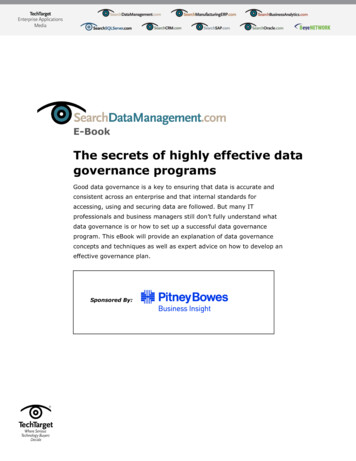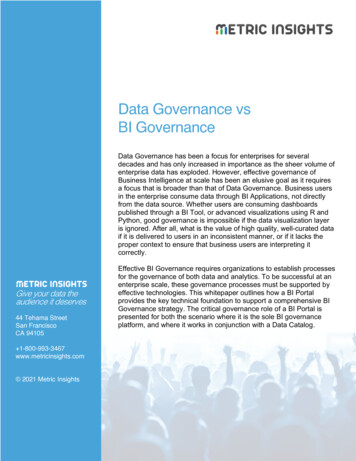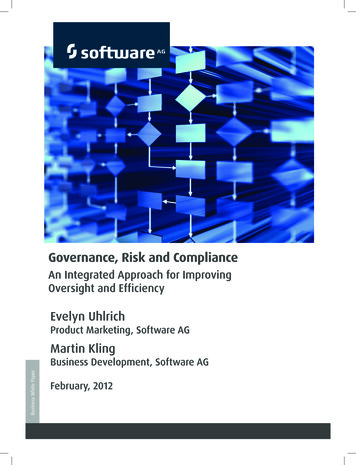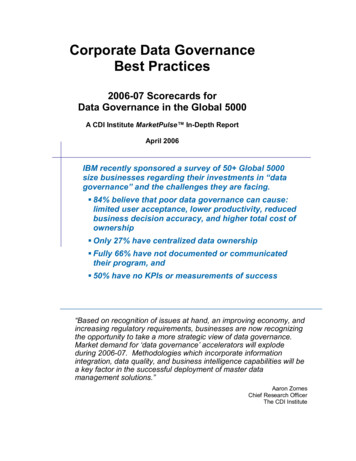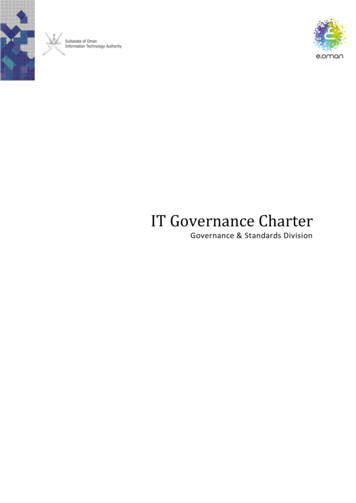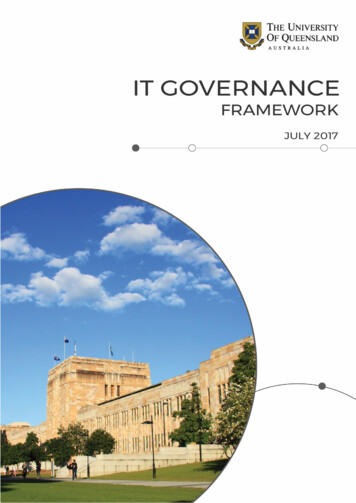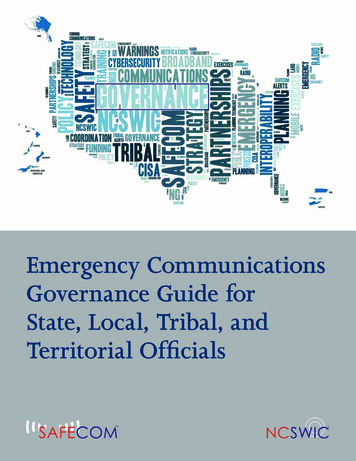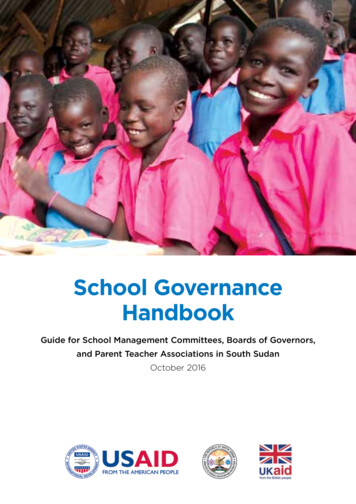
Transcription
School GovernanceHandbookGuide for School Management Committees, Boards of Governors,and Parent Teacher Associations in South SudanOctober 2016
For more information, please refer to the following source materials:Parent Teacher Association Training Manual. Ministry of General Education and Instruction. USAID andRoom to Learn. December 2015.School Governance Toolkit. Guide for School Management Committees and Boards of Governors.Juba, September 2014.2
AcknowledgementsThe School Governance Handbook is the result of a joint undertaking by the Ministry of GeneralEducation and Instruction (MoGEI), the USAID-funded Room to Learn (RtL) South Sudan projectimplemented by Winrock International in partnership with FHI360 and Plan International USA; andthe UKAid-funded Girls’ Education South Sudan (GESS) programme, managed by Mott MacDonald inpartnership with BBC Media Action, Charles Goldsmith Associates, and Winrock International.The entire staff of the Directorates of Basic and Secondary Education and Quality Promotion andAssurance (MoGEI) provided guidance during the development, review, and validation of the tworesource manuals that served as the basis of the content included in the Handbook. Special thanksgo to the following individuals who assisted in the development of content: Mr. Amot Okony, DirectorGeneral- Directorate of Quality Promotion and Assurance; Mr. Victor Akuk, Director of QualityPromotion and Assurance; Mr. John Lujang, Deputy Director for Quality Promotion; Mr. Bullen Daniel,Assistant Director- Curriculum Development Centre; Mr. Gibson Brown, Director of Primary Education;Mr. Nhial Johnson, Deputy Director of Secondary Education; Ms. Zeinab Yezinai, Deputy Director- LifeSkills and Nutrition; Mr. Kur Ayai, Senior Inspector of Primary Education; and Mr. Deng Simon, Inspectorof Primary Education. We would like to thank all the other MoGEI officials who participated in thevalidation process: Mr. George Ali, Development Partner Office; Mr. Mading Manyok, Department ofExaminations; Mr. Clement Kajokole, M&E Officer; and Mr. Gabrial Nuul, Deputy Director- AcceleratedLearning Programme.We would like to thank the primary schools that were consulted for content: Al Giada Primary School,Gudele East Primary School, Hai Malakal Primary School, Juba One Primary School, and Kinia PrimarySchool. We would like to thank all of our government and NGO partners, nationally and locally, for theirsupport in improving educational outcomes in South Sudan, including the UNICEF Education Clusterand the Global Partnership for Education.We thank the Room to Learn (RtL) team for their technical guidance and valuable contributions to theParent Teacher Association (PTA)-related sections of the Handbook: Mr. Iftikhar Ahmad, RtL ProjectDirector; Mr. Seth Ong’uti, Director of Education and Community Engagement; Dr. Edreda Tuwangye,Curriculum and Material Development Specialist; Mr. Andebo Pax Pascal, Teacher DevelopmentSpecialist; Ms. Margaret Ayite, Gender and Social Inclusion Specialist; Mr. Kanju Yakuma, EducationCapacity Building Specialist, Mr. Tom Willcox, Communications & Outreach Manager; Mr. Andrew Olal,Field Implementation; and Ms. Joan Sullivan-Owomoyela, formerly FHI360 Senior Education Adviser/Room to Learn Acting Education Director. From Plan International in South Sudan, we would also like tothank Mr. Angelo Lubang, Education Manager, for his support of this project.We thank the Girls’ Education South Sudan (GESS) team for their inputs relating to School ManagementCommittees (SMCs) and Boards of Governors (BoGs), especially all GESS State Anchor CountyEducation Officers involved in training for the SMC/BoGs across the country, whose advice and lessonslearnt from the training were included in this document; Mr. Andabati Omar and Mr. John Rubaihayo,the GESS Trainers whose observations shaped the content of the Handbook; Ms. Yolanda Ille, Educationand Gender Specialist; and Ms. Agnieszka Milulka, Quality Education Adviser, leading the work relatedto SMC/BoGs. Thank you to Mr. Jean Samuel Mfikela for providing the beautiful, locally-adaptedillustrations throughout the document.The project would not have been successful without the dedication and commitment of the project’sleadership team, which includes Ms. Katie Appel, Programme Manager- Plan International USA;3
Ms. Agnieszka Mikulska, Quality Education Adviser- GESS; Ms. Louise Leak, Emergency PreparednessSpecialist- RtL; and Dr. Valerie Haugen, Project Advisor- RtL. We would like to express utmostappreciation to Ms. Shari Bernstein, Instructional Materials Design Consultant, for her tirelesscommitment to the high quality content of the Handbook, and for Mr. Eric Alves, Graphics DesignConsultant, for his professional and polished design work.Finally, we would like to thank the United States Agency for International Development (USAID) and theUnited Kingdom's Department for International Development (DFID), which provided generous supportfor the development and production of the School Governance Handbook.Abdullahi AliDirector GeneralDirectorate of Basic and Secondary EducationMinistry of General Education and InstructionRepublic of South Sudan4
IntroductionWho Requested the School Governance Handbook?The Ministry of General Education and Instruction’s (MoGEI) Department of Quality Promotion andInstruction requested that development partners in the Technical Working Group on School Governanceassist in the compilation of a unified Handbook that would help enhance the understanding of schoolgovernance at the local level, building on existing resources. This document would further build thecapacity of members of school governing bodies, specifically, Parent Teacher Associations (PTAs), SchoolManagement Committees (SMCs), and Boards of Governors (BoGs). These three school governing bodiesare essential for addressing challenges to providing access to education and improving the quality ofeducation in early childhood development and in primary and secondary schools.What is the School Governance Handbook?The School Governance Handbook is a reference document in a user-friendly format. The Handbookoutlines the roles, responsibilities, and actions to be taken by the three bodies responsible for schoolgovernance at the local level: Parent Teacher Associations, School Management Committees, and Boardsof Governors.The School Governance Handbook incorporates content from two MoGEI-supported materials:1) the Parent Teacher Association Training Manual through the USAID-funded Room to Learn (RtL) SouthSudan project and 2) the School Governance Toolkit- Guide for School Management Committees andBoards of Governors through the UKAID-funded Girls’ Education South Sudan programme (GESS), tocreate one, unified resource guide.Who Uses the School Governance Handbook?The School Governance Handbook is intended to be used by members of PTAs, SMCs, and BoGs to helpthem understand their respective roles, responsibilities, and actions. The Handbook can also be of valueto local-level education administrators at the Payam and County Education Offices and to Head Teachersat primary and secondary schools. Others, such as education development partners, may also find theHandbook a useful tool as they undertake capacity building work with school governing bodies.How Should the School Governance Handbook Be Used?The Handbook can be kept at the school and used as a reference document. It can also be kept by eachPTA, SMC, and BoG member for their own individual use. The Handbook can be used by facilitatorsduring capacity building workshops for PTA, SMC, and BoG members.How Will the School Governance Handbook Be Made Available?The Handbook is available through the Ministry of General Education and Instruction and online throughthe USAID Development Experience Clearinghouse. For more information, please see the Parent TeacherAssociation Training Manual or the School Governance Toolkit- Guide for School Management Committeesand Boards of Governors, as mentioned above.Michael Lopuke LotyamUndersecretaryMinistry of General Education and InstructionRepublic of South Sudan5
AcronymsALPAccelerated Learning ProgrammeBALPBasic Adult Literacy ProgrammeBoGBoard of GovernorsCBOCommunity-Based OrganizationCECCounty Education CentreCEDCounty Education DepartmentDFIDUnited Kingdom's Department for International DevelopmentEiEEducation in EmergenciesGESSGirls’ Education South Sudan ProgrammeIECInformation, Education, and CommunicationM&EMonitoring and EvaluationMoESTMinistry of Education, Science, and TechnologyMoGEIMinistry of General Education and InstructionNGONon-Governmental OrganizationPESPayam Education SupervisorPTAParent Teacher AssociationRtLRoom to Learn South SudanSMCSchool Management CommitteeSMoEState Ministry of EducationSSPSouth Sudanese PoundTTITeacher Training InstituteUKAidUnited Kingdom's Department for International Development(See DFID above)UNICEFUnited Nations Children’s FundUSAIDUnited States Agency for International DevelopmentWHOWorld Health Organization6
Table of Contents1. Basics of School Governing Bodies. 9Republic of South Sudan National Policy on School Governance 10School Governance: Overview 11Forming the PTA 16*Parent Teacher Association Election Statement.23Forming the SMC/BoG 25*SMC/BoG Selection Statement.29PTA and SMC/BoG Duties: Overview 31Engaging the Community: Overview 37School Development Plan: Overview 45The School Development Plan: SMC/BoG Role 47*School Self-Evaluation Form. 49*Annual School Development Plan:.53The School Development Plan: PTA Role 56*Community Monitoring Form.59Managing School Funds: Overview 61Opening the School Bank Account: SMC/BoG Role 64Using the School Bank Account: SMC/BoG Role 66*Records of School Funds: Checklists.71Appendix I: PTA and SMC/BoG List of Activities for the School Year by Month 74Appendix II: Tables of PTA, SMC/BoG, and Head Teacher Duties 77Appendix III: The Government's Role in the School Development Plan 822. Supplementary Information for School Governing Bodies. 83Conducting Meetings: Overview 84Partnerships for School Development: Overview 88*Checklist for a Strong Partnership.93Gender Considerations: Overview 94Helping Learners Complete School: Overview 96*Templates in red are intended to be photocopied orused as sample worksheets for school governing bodies.7
PTA and SMC/BoG Sub-Committees: Overview 98Supporting Cash Transfers: Overview 100*Checklist for the Cash Transfer Programme.104Ensuring Safe Schools: Overview 105*Safe School Checklists.106Preparing for Disasters and Emergencies: Overview 109Preparing for Emergencies: Hazard Assessment 111*Hazard Assessment Chart. 113*Emergency Preparedness: Checklists.120Appendix IV: General Roles and Responsibilities in Emergency PreparednessMatrices 1213. School Governance in Emergencies Toolkit. 124Education in Emergencies: Role of the PTA and SMC/BoG 125Education in Emergencies: Needs Assessment 133*Community-based Education in Emergencies EiE Needs Assessment. 135*Templates in red are intended to be photocopied or8used as sample worksheets for school governing bodies.
1. Basics of SchoolGoverning BodiesSchool Governance Handbook9
Republic of South Sudan NationalPolicy on School GovernanceThe South Sudan General Education Act (2012) and the School Governance Policy(2014) set out the legal framework within which Parent Teacher Associations(PTAs) and Head Teachers in primary and secondary schools, School ManagementCommittees (SMCs) in primary schools, and Boards of Governors (BoGs) insecondary schools must operate.The South Sudan General Education Act, Article 29 states:“The School Governing Body shall be an authority on all matters related to finance,academic discipline, co-curricular activities, and the general welfare of the school.”“The administrative and professional management of the school shall be theresponsibility of the Head Teachers under the supervision of relevant ministries.”1Girls and boys go to school.The Ministry of Education in South Sudan has changed its name in the recent history. Some documents1were therefore written under the Ministry of Education, Science and Technology (MoEST) and otherdocuments are written under the Ministry of General Education and Instruction (MoGEI).10
School Governance: OverviewImportant wordsSchool GovernanceHow the school governing bodies lead, direct, and manage the schoolSchool Governing BodiesThe PTA, SMC, and BoGCommunityThe people and organisations related to the schoolPTAParent Teacher AssociationThe group of parents, teachers, and community members who come together tolead and help the schoolSMCSchool Management CommitteeThe group of parents, teachers, learners, and community members who manageand govern a primary schoolBoGBoard of GovernorsThe group of parents, teachers, learners, and community members who manageand govern a secondary schoolSchool Governance Handbook11
What does the law in South Sudan say aboutschool?Primary school is free.zzAllchildren must enrol in school by age 6.zzPublicprimary schools must accept children whose parents cannot pay relatedschool fees.All girls and boys ages 6 or older must go to 8 years of primary school,including:zzGirlsand boys from poor families;zzGirlsand boys with disabilities;zzGirlsand boys who are single or double orphans;zzGirlsand boys from all language groups;zzGirlsand boys in pastoral communities; andzzGirlsand boys who live on the streets or in institutions.The government pays for and provides:zzPrimaryschool teachers’ salaries and teacher subject guides;zzPrimaryschool registration fees; andzzPrimaryschool textbooks for all primary school subjects.Parents/caregivers pay for their child’s primary school uniform andsupplies and may be asked to contribute to the school developmentfund.Secondary school is not free.zzSecondaryschools may ask parents for money for the school development fund.The government pays for or provides:zzSecondaryteachers’ salaries and teacher subject guides.Parents/caregivers pay for:zzTheirchild’s secondary school test fees; andzzTheirchild’s secondary school textbooks, uniform, and other supplies.12
What does the law in South Sudan say aboutschool governance?Schools are governed locally.zzHeadTeachers, PTAs, and SMCs/BoGs work together to govern schools.zzTheyfollow the laws and policies for school governance.Schools must be safe places.zzThelaw says learners should not be hit at school by an adult.zzLearnerszzAdultsshould not be embarrassed, humiliated, or verbally abused at school.must not touch or talk to learners in inappropriate ways.zzLearnersmust not hurt each other.Important documents to know about:zzSouthSudan General Education Act (2012); andzzMinistryof General Education and Instruction School Governance Policy (2014).School governing bodies work with teachers and learners to improve the school.School Governance Handbook13
What is the difference between the PTA and theSMC/BoG?PTAs have teachers, parents, caregivers, and individuals as members whose childrenare learners in a school, and whose contribution to the school is recognised by thecommunity. The PTA meets at least once a term. The minimum number of membersfor a PTA meeting is 25.School Management Committees/Boards of Governors are part of Parent TeacherAssociations. SMCs/BoGs have teachers, PTA members, learners, community leaders,and representatives of professional bodies as members. The SMC/BoG meets at leastonce a month during school terms. The maximum number of people in a SMC/BoG is13. The SMC/BoG reports to the PTA.PTAs and SMC/BoGs support learners and the school community.14
What does the community do first to govern theschool?zzFirst,zzThen,zzThethe school needs to form the PTA.the school needs to form the SMC or BoG.people on the PTA and SMC/BoG are called members.PTA GeneralMembersPTA ExecutiveCommittee MembersSMC orBoG Members(1 female and1 male teacher)(1 female and1 male teacher)Parents andCaretakersCommunityLeadersHead TeacherTeachersLearnersProfessionalBodiesSchool Governance HandbookHead Girl andHead Boy1 woman or man froma professional body15
Forming the PTAImportant wordsPTA General AssemblyAll parents, caregivers, and community members who are signed up for the PTAPTA Executive CommitteePTA members elected as leadersOffice BearerA leader with a special rolePTA Sub-CommitteeA small group of PTA members with agreed-on tasksThe PTA General Assembly is the big group of all teachers, parents,and caregivers of learners.The PTA Executive Committee leads the work of the PTA.The PTA may have Sub-Committees to help with the PTA’s work.16
How does the community form the PTA?zzThePTA is voluntary.zzThePTA needs to elect mothers and fathers as PTA Executive Committee Members.Step 1: Conduct a PTA Start-up Committee Meeting.zzTheHead Teacher invites the Payam Education Officer, a woman from thecommunity or school, and 2 parents or caregivers to be on the Start-upCommittee.zzTheHead Teacher leads the start-up meeting and explains how to elect PTAExecutive Committee Members.zzTheStart-up Committee sets a time, place, and date for a communitymeeting to form the PTA General Assembly and elect the PTA ExecutiveCommittee.Step 2: Invite the community to the meeting to form the first PTAGeneral Assembly and elect the PTA Executive Committee.zzTheHead Teacher uses radio, talking, and letters to invite all parents andcaregivers.zzTheStart-up Commitee Members encourage women and men from all groupsin the community to come to the meeting.Step 3: Hold the meeting to form the PTA General Assembly andelect the PTA Executive Committee.zzTheHead Teacher and PTA Start-up Committee Members lead the meeting.zzTheHead Teacher explains the purpose of a PTA and the roles andresponsibilities of the PTA Executive Committee Members.School Governance Handbook17
The PTA Executive Committee and What It DoesPTA Executive Committee Members5 Executive Committee Members who are office bearersChairpersonPlans PTA meetings with the Head TeacherGoes to SMC or BoG meetings on behalf of the PTASigns official PTA papersVice ChairpersonHelps the Chairperson and acts as Chairperson, if the Chairperson is absentSecretary (Head Teacher)Helps the Chairperson plan meetingsKeeps records of PTA meetingsAsks the PTA Executive Committee for money for school activitiesTreasurerCollects money for school developmentKeeps records of the PTA budget, money, and spendingSecretary of InformationHelps the PTA, community, and school get informationTalks with the PTA about school and community mattersGoes to meetings about sports and social events on behalf of the PTA6 Executive Committee Members who are not office bearersOther Executive Committee MembersTalk with the communityLead special PTA Sub-CommitteesAttend PTA meetings18
When does the PTA elect Executive CommitteeMembers?The PTA elects Executive Committee Members when it forms the PTA.zzTheExecutive Committee Members are elected for 1 year.The PTA elects Executive Committee Members 1 time each year.zzTheExecutive Committee Members can be elected 3 years in a row.zzTheExecutive Committee Members cannot be elected more than 3 years in a row.The PTA may also need to elect Executive Committee Members atother times if there are fewer than 7 active Executive CommitteeMembers.The PTA Executive Committee leads the PTA and its activities in the school community.School Governance Handbook19
How does the PTA General Assembly elect the PTAExecutive Committee Members?The Start-up Committee and the Head Teacher lead the election.Step 1: Conduct the PTA General Assembly Meeting.zzTheHead Teacher and the PTA Start-up Committee Members lead the PTAGeneral Assembly meeting.Step 2: The Head Teacher explains the purpose of a PTA and theroles and responsibilities of the PTA Executive Committee.zzTheHead Teacher explains what PTA office bearers do.zzThePTA Start-up Committee explains there are 11 PTA Executive CommitteeMembers.zzThePTA will elect a total of 8 female and male Executive CommitteeMembers.zzThePTA will not elect the 3 teachers who are Executive Committee Members.Step 3: Identify people who may be strong PTA ExecutiveCommittee Members.zzThePTA Start-up Committee asks people at the meeting to identify womenand men who can be strong PTA Executive Committee Members.zzThePTA Start-up Committee makes sure the people identify some women.zzThePTA Start-up Committee makes sure the people identify representativesfrom many different groups in the community.20
Step 4: Vote for PTA Executive Committee Members.zzThePTA Start-up Committee asks the people to choose a way to vote for thePTA Executive Committee Members. Ways to vote may include paper ballots,simple hand count, or queuing up behind the person of choice.zzThePTA Start-up Committee conducts the vote for each PTA ExecutiveCommittee position.zzThePTA Start-up Committee counts the votes of women and men in thesame way.zzThePTA Start-up Committee makes sure women and people from differentgroups are part of the PTA Executive Committee.zzThePTA Start-up Committee tells the people the results of the voting.Step 5: The women and men with the most votes are the newExecutive Committee Members.A parent who serves as a PTA Executive Committee Member becomes a leader at the school.School Governance Handbook21
How does the PTA Start-up Committee report theelection results?Step 1: Write a statement about the election results.zzTheStart-up Committee writes a statement about the election results.zzTheStart-up Committee makes three extra copies of the statement.zzTheHead Teacher keeps one statement.Step 2: Submit two statements to the Payam Education Office.zzTheHead Teacher submits two copies of the statement to the PayamEducation Supervisor.zzThePayam Education Office works with the Head Teacher to help SMC/BoGmembers fulfil their roles by building their knowledge and skills.Step 3: Submit one statement to the County Education Office.zzThePayam Education Supervisor submits one copy of the statement to theCounty Education Office.zzTheCounty Education Office officially recognizes the PTA ExecutiveCommittee.22
Parent Teacher Association Election StatementName of the School:Date:The Head Teacher, Deputy Head Teacher, teachers, PTA members, and representativesof the community gathered to elect the PTA Executive Committee, which supportsthe management of school affairs, helps teachers to understand learners and theirhome environment, and strengthens collaboration between the home and the school.The following members were elected to represent our voices in the PTA body, andthey confirmed that they understood that the school PTA is a voluntary erson03Secretary04Treasurer05Secretary ofInformation06Non-OfficeBearer 107Non-OfficeBearer 208Non-OfficeBearer 309Non-OfficeBearer 410Non-OfficeBearer 511Non-OfficeBearer 6NameSchool Governance HandbookInterest group(Parent, teacher,school, orcommunitymember)Gender(Femaleor male)Phone23
How often does the PTA meet during the year?The PTA meets at least 3 times during the school year.zzThePTA meets at least 1 time each term.zzThePTA Executive Committee meets with the Head Teacher 2 times a term.PTA members visit the school at least 1 time each term.How are PTA Executive Committee Members removed?PTA Executive Comittee Members can be dismissed if they do not dotheir duties.zzAmember who is not active or does not do his or her duties can be dismissed.zzThezzAPTA can decide if a member is no longer able or fit to be a member.member who misses 3 or more than 3 PTA meetings in a row without clear reasonscan be dismissed.PTA Executive Committee Members can be dismissed if they breakimportant rules or laws.zzAmember may be removed if convicted of an offence involving fraud.zzAmember may be removed for criminal offences.zzAmember may be removed for misconduct.zzAmember may be removed for a violation of PTA responsibilities.The PTA Executive Committee may call a vote for a member's dismissalfrom the PTA Executive Committee.zzTheChairperson or Vice Chairperson tells the PTA Executive Committee membersabout the member's possible reasons for dismissal.zzThemember facing dismissal may want to defend his or her case before the PTAExecutive Committee.zzWaysto vote for dismissal may include paper ballots or simple hand count. If themajority of members vote for dismissal, the member will be asked to leave the PTAExecutive Committee.A member may choose to leave the PTA Executive Committee.A new PTA Executive Member is elected to replace any member wholeaves before finishing 1 year.24
Forming the SMC/BoGImportant wordsOffice BearerA leader with a special roleSub-CommitteeA small group of people with agreed-on tasksThe SMC/BoG governs and manages the school for the Ministry ofGeneral Education and Instruction.The SMC/BoG has members and office bearers to lead its work.The SMC/BoG may have Sub-Committees to help with tasks.The SMC/BoG identifies needs at the school and supports efforts to address them.School Governance Handbook25
The SMC/BoG and What It DoesSMC/BoG members4 members who are office bearersChairpersonLeads the SMC/BoGPlans SMC/BoG meetings with the Head TeacherArranges and lead the meetingsTalks with the PTA on behalf of the SMC/BoGOpens and manages the school bank accountEnsures SMC/BoG members participate in meetingsVice ChairpersonHelps the ChairpersonActs as Chairperson, in absence of the ChairpersonSecretary (Head Teacher)Helps the Chairperson plan meetingsKeeps records of SMC/BoG meetingsTells the school community about SMC/BoG activities and eventsTreasurerManages grants, including the capitation grantKeeps records of the school’s budget, money, and spendingHelps open the school bank account9 SMC/BoG members who are not office bearersOrdinary membersMonitor school performanceLead special SMC/BoG Sub-CommitteesManage school fundsManage school development planning processSupport improvement of teaching and learningMonitor school progressAttend SMC/BoG meetingsSupport the community to send children to school, including those who are:zzmarried,including those with their own children;zzinchild-headed households;zzinfemale-headed households;zzwithdisabilities; and/orzzemployed26in formal or non-formal employment
How does a school start the SMC/BoG?Step 1: The PTA and school staff have a meeting to agree on how toselect SMC/BoG members. Members should include:zzResponsibleand respected people who are not PTA Executive Committee Members;zzWomen;zzParentszzPeopleor household members o
What is the School Governance Handbook? The School Governance Handbook is a reference document in a user-friendly format. The Handbook outlines the roles, responsibilities, and actions to be taken by the three bodies responsible for school governance at the local level: Parent Teacher Associations, School Management Committees, and Boards of .


